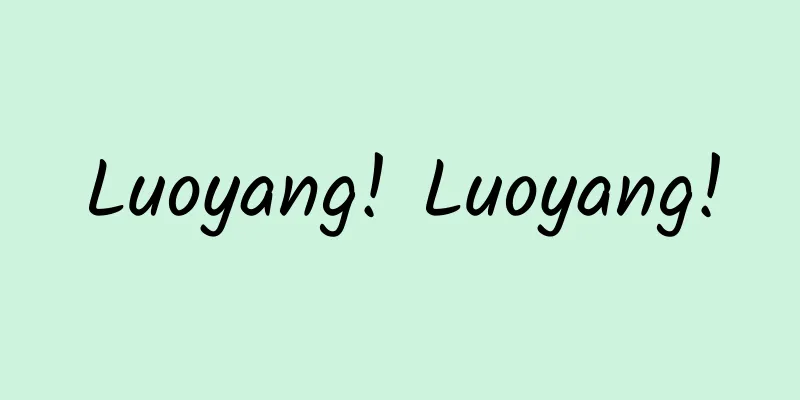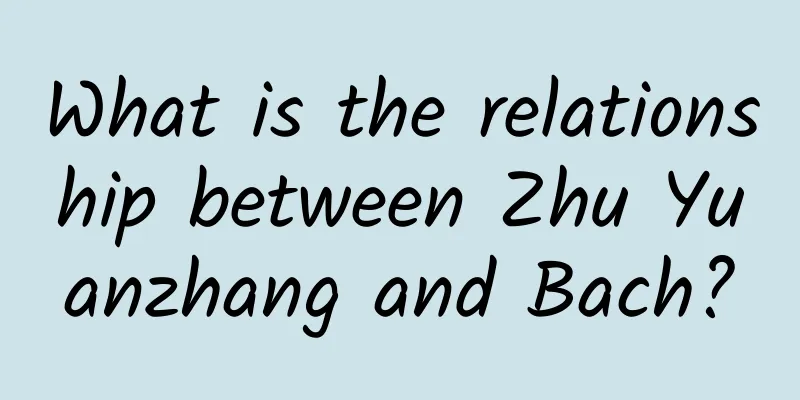Luoyang! Luoyang!

|
Luoyang A name that goes deep into the Chinese spirit It used to It is poetry and myth It is the most beautiful city in the hearts of countless people. (From Zhu Dunru's "Partridge Sky·Xidu" by Song Dynasty) ▼ Jade Tower and Golden Palace Let's plant plum blossoms and get drunk in Luoyang (Laojun Mountain after the snow, photographer @史远) ▼ It once represented the The most amazing time The majestic emperor drove six The ancient Baima Temple with its fragrant incense And the Longmen Grottoes, which are visited by many people It makes people think of the hustle and bustle of the past. (Longmen Grottoes is one of the four major grottoes in China and a must-see for tourists visiting Luoyang. Photographer: @许河源) ▼ But it also It is also a city full of sadness. It is the ancient capital of 13 dynasties. Countless wars, countless ups and downs Let it gradually sink into the sea of history "If you want to know about the rise and fall of the past and present, please just look at Luoyang City" Until the founding of New China Luoyang finally found its direction (Sketch of the location of the ancient city of Luoyang, drawn by @郑艺/Planetary Research Institute) ▼ Luoyang! Luoyang! For us What does it mean? now When we look at the scale of thousands of years Looking at the history of Luoyang You will find It is the holy land of Chinese civilization. It is also an important town for the industrial construction of the Republic. It is unforgettable, forever and ever God's Capital 01 In China In fact In terms of geographical endowment Luoyang is one of the many ancient capitals in China. Outstanding From a macro perspective It is located in the center of China's territory Looking north to Taihang Mountain and south to Jianghuai River It borders the North China Plain to the east and the Guanzhong Basin to the west. (Location and topography of Luoyang, drawn by @Zheng Yi/Planetary Research Institute) ▼ From a micro perspective Luoyang can be described as "surrounded by mountains and rivers". Including Xiao Mountain, Xiong'er Mountain, Waifang Mountain, Funiushan Mountain, etc. Qinling Mountains Winding from the West Like a giant open hand Embedded in the southwest of Luoyang The altitude is over 2000 meters (Please watch in horizontal mode, sunrise over Laojun Mountain and sea of clouds, photographer @王煜文) ▼ also Songshan Mountain stands in the east Mang Mountain lies in the north Like a military barrier Guarding the Luoyang Basin in the middle (The scenery of Mangshan Mountain along the Yellow River in Gongyi City; Gongyi is now part of Zhengzhou, and historically it was under the jurisdiction of Luoyang for a long time. Photographer: @郭少宁) ▼ And from the fingers of the mountain Dense streams gurgle out Converges into Yi River and Luo River (In the southern suburbs of Luoyang, the Yi River passes through Longmen Mountain and Xiangshan Mountain. Photographer: @傅鼎) ▼ Two Rivers in Luoyang Basin Alluvial deposits create fertile land Then they meet in the south of Mangshan And pour into the Yellow River (Please watch in horizontal mode, Xiaolangdi Reservoir of the Yellow River located in the north of Luoyang, photographer @王煜文) ▼ that's all Luoyang is located in the center of China The land is fertile, with abundant water resources and mountains. Such a beautiful land Just waiting for someone to come? 02 The beginning of the capital Let us turn our attention Investing in China 5,000 years ago At this time, China It has given birth to many prehistoric civilizations They are scattered everywhere As bright as a sky full of stars The ancestors who lived in the Luoyang Basin Taking advantage of being in the middle of China Convenient communication with all parties Absorb advanced culture from all over the world (Hole-punched pottery stand, unearthed from Wangwan Site in Luoyang, image source: @Visual China) ▼ About 4200-4000 years ago Abrupt global climate change Completely disrupted the development process of various places Cold and drought swept Inner Mongolia and northern Shaanxi Heavy rains and floods hit the middle and lower reaches of the Yangtze River The former "sky full of stars" Lost its luster for a while Only the Central Plains region including the Luoyang Basin Because the location is neither north nor south Relatively mild climate The disaster was relatively minor. The central location It also enables long-term communication with all parties Bringing people more mature social organization capabilities Finally stood out (Agricultural progress was also one of the conditions for our ancestors to overcome disasters; the picture shows spring plowing in Luoyang farmland, photographer @李文博) ▼ Their tribal leader Ascend the hereditary throne Establishing an efficient and stable new order A new dynastic state Born It is considered by many people It is the Xia Dynasty recorded in history books. (Grid-patterned bronze tripod, photographer @丁俊豪) ▼ As time goes by The dynasty's power became increasingly centralized A new capital is coming Where is the royal capital located? In recent years, many people have speculated that It is located in Yanshi, Luoyang today. Erlitou Site From the appearance, it can be seen This is a carefully planned and constructed city. The crisscrossing “井”-shaped main roads Divide the city into different functional areas At its center The palace where the ruler lived (Schematic diagram of the Erlitou site layout, drawn by @Luo Zihan/Planetary Research Institute) ▼ It includes a main hall, corridors, courtyards, etc. The royal palace and ancestral temple and an altar shaped like a round table with a round pit inside. The decree was issued here Humans and gods communicate here They are the heart of this capital. (Reconstruction diagram of the main hall of Palace No. 1 at the Erlitou site, drawn by @Luo Zihan/Planetary Research Institute) ▼ Outside the Palace There are many small and medium-sized houses And various workshops in the north and south To meet the production and living needs of the entire society The artifacts produced by these workshops It shows that it is a "technological power" and a "manufacturing power" People can make A 65cm long jade knife (Seven-hole Jade Knife, photographer @丁俊豪) ▼ Can produce The earliest bronze jue and bronze ding in China This was the most advanced bronze casting technology at the time. (The bronze jug with nipple pattern is known as "the first jug in China", photographer @范沛卓) ▼ You can also inlay turquoise on bronze Making a turquoise animal-faced bronze plaque (Turquoise animal face bronze plaque, photographer @Jimmy's Little Universe) ▼ And a 64.5 cm long Turquoise dragon shaped vessel It is composed of more than 2,000 pieces of turquoise. Curved and radiant (Please watch in horizontal screen, turquoise dragon-shaped vessel, now in the collection of the Institute of Archaeology, Chinese Academy of Social Sciences, photographer @李文博) ▼ These heavy and exquisitely crafted objects Born out of the rulers' control over resources and population Strong control It has thus become a symbol of royal power and order. As objects circulate in all directions The order behind it It is also radiating to the surrounding Fangguo tribes. Form a closer centripetal force among them And this "heart" The King's Capital Luoyang (Erlitou Xia Capital Ruins Museum, photographer @石耀臣) ▼ After this Merchants from the East Also chose to establish his own ruling order in Luoyang It is centered around today's Luoyang Yanshi area. Build a city, establish a country, and govern Over a hundred years (Mother drum square jar léi, unearthed from the Luoyang Beiyao site, photographer @李琼) ▼ Zhou people from the west While the capital was in Guanzhong Heluo region is also favored In their opinion Luoyang is the "center of the world" Better for controlling all sides (From "Records of the Grand Historian: Annals of Zhou") ▼ In this world, the tribute roads from all directions are Therefore, they are in the Luoyang Basin Building the Eastern Capital Chengzhou This will help to conquer Kanto and make up for the disadvantage of the capital being located to the west. This was the prototype of the "Two Capitals System" in later generations. Legend has it that in the process The Nine Cauldrons, symbolizing royal power, were also placed in Luoyang. The origin of the idiom "定鼎中原" (The He Zun was unearthed in Baoji, Shaanxi. The 122-character inscription inside it mentioned that King Wu of Zhou planned to build Luoyang, calling it "Zhezi Zhongguo". This is also the earliest written record of the word "China". Photographer @脉影) ▼ The end of the Western Zhou Dynasty King Ping of Zhou tried to avoid the danger of the Quanrong Leaving Guanzhong and moving the capital to Luoyang The Eastern Zhou Dynasty, which lasted for more than 500 years, began (Wangcheng Park built on the ruins of the Eastern Zhou Dynasty Royal City, photographer @李琼) ▼ Eastern Zhou Dynasty The princes rose up and rituals and music were destroyed Heroes "strive for the Central Plains" But the capital of Luoyang It is still the center of national economic and cultural exchanges. (Bronze gear, unearthed from the ruins of the Eastern Zhou Dynasty Royal City, may be a mechanical brake device, photographer @李琼) ▼ after The wheel of history rolls forward In 221 BC, Qin unified the six kingdoms 202 BC The Han Dynasty founded by Liu Bang established its capital in Chang'an Power from Guanzhong Create an unprecedented feudal empire Luoyang, the former capital Where to go? 03 Towards the Capital of Gods 25 AD The newly established Eastern Han regime Ended the long war Once again faced with the problem of choosing a capital city Luoyang is located in the middle Convenient material supply and other reasons Stand out again Became the capital of the Chinese Empire (Hangu Pass Ruins in Xin'an County, the location of Hangu Pass in the Han Dynasty, photographer @李文博) ▼ Afterwards To Cao Wei and Western Jin In the past 300 years Although Luoyang has experienced many wars and destructions, It has long been the center of dynastic rule. (Cao Wei white jade cup, unearthed in Jianxi, Luoyang, now in Luoyang Museum, photographer @张艳) ▼ 493 AD Even the Northern Wei Dynasty, founded by the Xianbei people, He also moved the capital from Datong to Luoyang, the center of China. In order to implement the Chinese reform This period Luoyang has a prosperous culture Cao Zhi composed "Ode to the Goddess of Luo River" Fictional love with the goddess of Luo River The most imaginable (The Goddess of Luo River was created by Gu Kaizhi of the Eastern Jin Dynasty based on the Goddess of Luo River. The version in the picture is a copy, which is collected by Liaoning Provincial Museum. The photographer is @张艳) ▼ Zuo Si, a writer in the Western Jin Dynasty He composed the famous poem "Fu of Three Capitals" in Luoyang It triggered nationwide copying and paper prices rose This is why "Paper is expensive in Luoyang" (Longma Futu Temple in Mengjin is said to have been built in the Jin Dynasty as a place for worshipping Fuxi. Photographer: @许河源) ▼ The newly introduced Buddhism Combined with the needs of the ruler He built Buddhist temples and excavated grottoes in Luoyang The first official temple in Chinese history, White Horse Temple Established in Luoyang during the Eastern Han Dynasty It is considered the "ancestral temple" of Chinese Buddhism. (White Horse Temple, photographer @丁俊豪) ▼ A famous book from the Northern Dynasties, Records of Buddhist Monasteries in Luoyang I admire the Buddhist temple in Luoyang, Northern Wei Dynasty. At one time, there were more than a thousand Including the most magnificent wooden structure in the history of Chinese Buddhism The Yongning Temple Pagoda is over 120 meters high. In contrast The tallest surviving ancient wooden pagoda in China, the Yingxian Wooden Pagoda It is only 67 meters high. (A clay sculpture of a human face unearthed from the Yongning Temple Pagoda, photographer @李文博) ▼ Yique, located in the southern suburbs of Luoyang The Yi River flows through here Since the Northern Wei Dynasty, on the cliffs on both sides of the river Cave digging Longmen Grottoes now There are more than 2,300 caves from various periods here. There are more than 100,000 statues in total. They are of different ages and shapes. Frowning or smiling, lifelike (Please watch horizontally, panoramic view of the west side of Longmen Grottoes, photographer @孙业林) ▼ In the Sui and Tang Dynasties Unprecedentedly large territorial boundaries and unprecedentedly developed socio-economic Requires countries to have stronger Control and carrying capacity Chang'an has stronger defensive capabilities The location is relatively west, and the transportation of materials is inconvenient Luoyang has convenient transportation But it is weaker than Chang'an in military defense. then Sui and Tang dynasties carried forward the Western Zhou Dynasty's two-capital system Chang'an and Luoyang were the two capitals Mutual support and mutual dependence The two cities also welcomed The most glorious peak in the history of ancient urban development (Illustration of the implementation of the "two capitals system" in the Sui and Tang dynasties, drawn by @Luo Zihan/Planetary Research Institute) ▼ Emperor Yang of Sui even dug With Luoyang as its center, it is over 5,000 miles long. Grand Canal of Sui and Tang Dynasties Make Luoyang the national water and land transportation hub (Sketch of the Grand Canal of the Sui and Tang Dynasties, drawn by @Zheng Yi/Planetary Research Institute) ▼ Luoyang City of Sui and Tang Dynasties Across the Luo River Presents a basically regular square 11 North-South Expressways Intersecting with 11 east-west avenues Divided into more than 100 lifang (Schematic diagram of the layout of Luoyang City in the Sui and Tang Dynasties, drawn by @郑艺&cc&雨菡/Planet Research Institute) ▼ Tianjie, which faces the south gate of the imperial city 100 meters wide Cherries and pomegranates are planted along the roadside (Dingding Gate is the south gate of the outer city of Luoyang during the Sui and Tang dynasties. The picture shows the reconstructed building. Photographer: @唐振明) ▼ A special place was built east of the imperial city. Large national grain storage center The area is as high as 430,000 square meters Hanjiacang City (In addition to Hanjia Granary, there are many granaries in and around Luoyang City. The picture shows the ruins of Huiluo Granary located in Xiaoli Village, Luoyang City today. Photographer: Huang Zhengwei) ▼ When Wu Zetian ascended the throne in Luoyang Changed it to Shendu The city was undergoing massive construction and adding palaces Various gardens were built It is said that peony became popular in Luoyang from then on. The most ambitious project Mingtang It is the main hall of Luoyang Palace. The base is octagonal The lower layer is a square, representing the four seasons of the year. The middle layer is a dodecagon, representing the twelve hours of the day. The upper layer is a 24-sided polygon, representing the 24 solar terms in a year. (The Mingtang was first built on the eve of Wu Zetian's enthronement and was destroyed during the reign of Emperor Xuanzong. The picture shows the Mingtang in the Mingtang Paradise Scenic Area in Luoyang today. The height and size are different from those in the Wu Zhou period. Photographer: @唐振明) ▼ Outside the city The famous Vairocana Buddha was carved in Longmen The entire Buddha statue is 17 meters high Smiling, respectful and not fearful It is the highest achievement of Tang Dynasty sculpture. (Lushena Giant Buddha, photographer @纪睿泓) ▼ Luoyang City Skilled craftsmen from all walks of life Ceramics, lacquered wood, gold and silver wares All are natural treasures (Exquisite Tang tri-color pottery, all stored in Luoyang Museum, photographer @焦潇翔) ▼ Hu merchants in the Western Regions Also came with their spice jewels Luoyang, one of the starting points of the Silk Road It has long been an international metropolis (The Nestorian Scripture Pillar of the Qin Dynasty, unearthed in Lilou Township, Luoyang, photographer @李琼) ▼ Everything in the prosperous age Like a dream However With the outbreak of the Anshi Rebellion The song of the colorful feathered clothes Luoyang City also went from prosperity to decline. "Four thousand miles from Luocheng, the Hu cavalry drove for five or six years" The poet Du Fu traveled west from Luoyang Overnight in Shihao Village, Xin'an County But I encountered a scene where officials were conscripting men from the village at night. (From Du Fu's "The Stone-Haul Officer") ▼ At dusk, I arrived at Shihao Village, where an official was arresting people at night. The old man climbed over the wall and the old woman went out to see. How angry the official shouted! How bitter the woman cried! The late Tang poet Wei Zhuang parted with his lover Lovers are reluctant to leave "Advise me to return home early, the people at the green window are like flowers" But in the end it can only be "Luoyang is a beautiful city in spring, but the talented people from Luoyang grow old in other places" (Throughout the Tang Dynasty, many scholars and writers gathered in Luoyang, and its rise and fall were also recorded in poems. Among them, Bai Juyi wrote about Luoyang most frequently; the picture shows Bai Juyi’s tomb, located on Xiangshan Mountain by the Yi River, photographer @李琼) ▼ Since then Continued turmoil, overdevelopment Luoyang is getting worse As China's political and cultural center for thousands of years, it This is how it began to decline Although the Five Dynasties Later Liang, Later Tang, and Later Jin briefly established their capitals here Although the Northern Song Dynasty Luoyang is still a large city. It is still a place where scholars gather and culture flourishes. (Luoyang is the hometown and teaching place of Cheng Yi and Cheng Hao, masters of Neo-Confucianism in the Northern Song Dynasty. The picture shows the hometown of the two Chengs in Song County, Luoyang. Photographer: @石耀臣) ▼ However, as the economy of Jiangnan continued to prosper The country's political center also moved eastward Kaifeng has better water transportation conditions Luoyang at this time No longer able to serve as the core of a country Countless people sighed and lamented People chant the name of Luoyang Imitating Luoyang's architecture Even many places are named Luoyang (From Lu You's "Dreaming of Seeing Peonies in Luoyang, So Beautiful That I Woke Up and Wrote a Poem") ▼ I have forgotten everything in the world as I grow old, but I still see the flowers in Luoyang in my dreams In the Ming and Qing Dynasties Luoyang's status further declined Becoming a regional center (Located in the southern suburbs of Luoyang, Guanlin has become a sacred place for Guan Yu's belief because of the burial of Guan Yu's head. It is also the only ancient building complex in my country that combines tombs, temples, and forests. Its existing buildings were mainly built in the Ming Dynasty. Photographer @丁俊豪) ▼ In the late Qing Dynasty and the Republic of China The whole of China is in danger Luoyang's fate is even more tortuous In 1932, the "January 28 Incident" broke out The Japanese army attacked Shanghai, and Jiangsu and Zhejiang were in danger The Nanjing National Government temporarily moved to Luoyang But at this time, Luoyang was already in ruins. The roads are all sand and dirt, and there is not a single electric light in the old city. During the Anti-Japanese War Luoyang as a national defense fortress on the battlefield of Henan, Hunan and Guangxi It was repeatedly bombed by the Japanese army. The city was a scorched earth, and 60% of the city was destroyed. (The Chiang-Song Villa, located in Longmen Xiangshan, Luoyang, was built in 1936 and was Chiang Kai-shek’s “temporary palace” in Luoyang. Photographer: Ding Junhao) ▼ When New China was founded There are only 70,000 people in Luoyang There are less than 3,000 artisans The whole city seems to be stopped in time The elegant Luoyang flower Has become a dream memory The vicissitudes of Luoyang City Will it sink into oblivion? 04 Ancient Capital Reborn The surging Yellow River Washing away the rise and fall of history The divine capital city that was glorious in agricultural civilization Although it is difficult to reappear in the world However, with the development of socialist construction in New China Luoyang ushered in its rebirth in the industrial age 1950s To achieve industrialization New China is in need of reconstruction The First Five-Year Plan was implemented The focus is on 156 projects assisted by the Soviet Union That is "Project 156" (Illustration of the industrial nature of Project 156, drawn by @Luo Zihan/Planet Research Institute) ▼ The new China at that time Still facing severe external threats Safety Become an important consideration in project site selection In this situation Luoyang's geographical advantages are highlighted again It is located inland, surrounded by mountains and rivers. And there is a huge agricultural population and market demand in the surrounding area Very suitable for the production of agricultural machinery 1954 After repeated investigation and demonstration first tractor factory Flowers fall in Luoyang (Overlooking the YTO factory in Luoyang today, photographer @焦潇翔) ▼ also There are also a large number of upstream and downstream projects settled in Luoyang Including Luoyang Copper Processing Plant, Luoyang Thermal Power Plant, Henan Diesel Engine Plant Luoyang Ball Bearing Factory, Luoyang Mining Machinery Factory, etc. A total of 6 "156 Project" projects And many supporting small and medium-sized enterprises and scientific research institutes (Distribution of major construction projects in Luoyang during the First Five-Year Plan, drawn by @郑艺/Planet Research Institute) ▼ At the call of the country Technical talents and workers from all over the country gathered in Luoyang Devoting ourselves to the industrial construction of Luoyang From 1953 to 1956 In just four years Luoyang's urban population has tripled (Sketch of population changes in Luoyang, drawn by @罗梓涵/Planet Research Institute) ▼ As for the 1960s Luoyang is already full of factories of all sizes. It has become an important base for China's machinery industry (Luoyang's petrochemical industry is also very strong. The picture shows the factory of Sinopec Luoyang Petrochemical Company. Photographer: @焦潇翔) ▼ As population and industry gather Luoyang's Urban Structure There has also been a fundamental change It is different from other ancient capitals which are often built around the old city. Instead, the old and new urban areas are separated and developed relatively independently. Evolved into a typical "strip city" At the beginning of the construction of "Yituo" For the purpose of cultural heritage protection The factory site avoids the old city and many ancient city sites Choose to build a new industrial city west of Jianhe River Therefore, this place is named "Jianxi District". (Please watch in horizontal mode, panoramic view of Jianxi District, photographer @王煜文) ▼ Under the grand plan A new industrial city rises from the wilderness Industrial areas are concentrated on the north side of the block Lined up along the Longhai Railway It accounts for 1/3 of the planned area of Jianxi District The residential area is located in the middle of the block There is a wide green belt between the industrial area and the It is divided into 76 "neighborhoods" of varying sizes. It has distinctive Soviet architectural features (Please watch in horizontal screen, the Soviet-style buildings in Jianxi, photographer @张岳) ▼ South of residential area It is a concentrated commercial area There are many shops moved in from Shanghai, Guangzhou and other places. Research institutes and universities It is concentrated at the southernmost end of the entire block. (Henan University of Science and Technology moved from Beijing to Luoyang in 1956. The picture shows the night view of its library. Photographer: @张孟尧) ▼ This industrial new town coexists with the old town Self-contained and closely connected The layout and style of the ancient city are well preserved. This is also known as the protection of large sites. The Luoyang Model After the Reform and Opening Up Luoyang is like other old industrial bases. Once encountered development difficulties From industrial structure to urban construction New battlefields need to be opened up The first to achieve a breakthrough It is an upgrade in the industrial field With the efforts of major scientific research institutes Traditional industries based on resources and labor Infused with technology Various innovative achievements and products emerge in an endless stream (Please watch in horizontal mode. The world's largest 18,500-ton forging hydraulic press is operating in a factory in Luoyang. Photographer: Huang Zhengwei) ▼ The "Dongfanghong" that was once famous in China Transformed into 5G+Hydrogen-fueled electric driverless tractor Robots used in underwater detection, mining security and other fields They were also born in factories in Luoyang. In addition to mechanical manufacturing Luoyang has gradually become China's "Industrial Design Capital" It owns Luotu Institute and CITIC Heavy Industries Two national industrial design centers The style of Erlitou as a "manufacturing powerhouse" in the past Reappearance in Heluo Land (5G+hydrogen fuel electric unmanned tractor, photographer @黄政伟) ▼ also Luoyang's rich history and culture It is also becoming its business card for development. As early as 1983 Luoyang held the first "Peony Culture Festival" When the peonies are in full bloom in April and May every year Attracting tourists from all over the world to visit So far, 39 sessions have been held (Peony and tree peony belong to the same genus, and are often planted together with tree peony to show the beauty of spring; the picture shows the blooming peony in Mingtang Paradise Scenic Area, photographer @雪儿) ▼ Traditional culture has also been reborn. A piece of past events Being brought to the public stage (Luoyang Yingtian Gate, the filming site of the Henan Lantern Festival Gala "Tang Palace Night Banquet", picture source @Visual China) ▼ Handicrafts Endowed with the ingenuity of the times (In Mengjin Sancai Town, a master is making Tang Sancai, photographer @邓国晖) ▼ And that ancient capital solidified in bricks, tiles and vegetation And returned to the world with a new attitude The area is more than 2,800 acres Sui and Tang City Ruins Botanical Garden Lying quietly by the Luo River (Sui and Tang Dynasty City Ruins Botanical Garden, photographer @石耀臣) ▼ Museums of various themes More than 100 companies Recording the vicissitudes of the past and present in all aspects (Luoyang Museum, photographer @石耀臣) ▼ The city gate and square were renovated on the original site Showing the elegance and splendor of the past (The rebuilt Lijing Gate is integrated into Luoyang Old Street. Photographer: Ding Junhao) ▼ While retaining the classical beauty Its urban framework is also expanding Reflecting the light of modernity everywhere Luoyang New District, south of Luo River There are universities, parks and sports stadiums scattered around. Full of vitality and energy (Please watch in horizontal mode, the scenery of Luoyang New District, photographer @王煜文) ▼ The flyover bridge spanning the Luo River from north to south Integrate the old city with the new city (Xiyuan Interchange, photographer @张孟尧) ▼ Luoyang Metro connects east and west As if traveling through time and space ("Luoyang Metro Made in Luoyang", brand new trains were transported from Luoyang CRRC Corporation to the test site; Luoyang is also the only non-provincial capital city in the central and western regions with a subway, picture source @Visual China) ▼ In this intersection of ancient and modern times Luoyang is reborn as Luoyang Although it has not frequently appeared in the spotlight of the times But as long as you embark on a journey to the ancient capital You can experience its charm and legend This is Luoyang It has influenced Chinese civilization for thousands of years. Leaving a mark in the hearts of every Chinese It has experienced ups and downs But still persist in moving forward Luoyang Never Forget Will not be forgotten The ancient nation is on the road to revival Ancient Capital of Gods Will be evergreen (From "Spring Day in the Capital" by Du Shenyan of the Tang Dynasty) ▼ A message to Luocheng: May the spring scenery be twice as beautiful next year (Please watch in horizontal mode, brilliant fireworks illuminate the night sky of Luoyang, photographer @李玉杰) ▼ This article was created by Written by | Bei Luoshimen Editor | Director Photo | Zhou Xuguang Map | Zheng Yi Design | Luo Zihan Proofreading | Changchun Ding Jiaxin Hogapi Chen Zhihao Cover Photographer | Wu Bin Head Photographer | Tang Zhenming 【References】 [1] Luoyang Local History Compilation Committee. Luoyang City Annals[M]. Zhengzhou: Zhongzhou Ancient Books Publishing House, 1995 [2] Luoyang City Cultural Relics Administration. Ancient Capital Luoyang[M]. Beijing: Chaohua Publishing House, 1999 [3]Guo Shaolin. History of Luoyang during the Sui, Tang and Five Dynasties[M]. Beijing: Social Sciences Academic Press, 2019 [4] Han Jianye. The Origin of Chinese Civilization[M]. Beijing: China Social Sciences Press, 2021 [5] Du Jinpeng. Preliminary study on the foundation of the palace building at Erlitou site[J]. Archaeological Journal, 2006 [6] Ma Shaoping. Research on Luoyang, the Temporary Capital of Nanjing National Government[D]. Kaifeng: Henan University, 2015 [7] Ding Yiping. 1953-1966: Industrial Migrants and Social Change in Luoyang City[D]. Shijiazhuang: Hebei Normal University, 2007 [8] Bai Xue. Research on the Construction History of the First Tractor Manufacturing Plant[D]. Guangzhou: South China University of Technology, 2016 [9] Sun Yuejie. Historical Research and Value Analysis of Luoyang 156 Industrial Heritage Group[D]. Tianjin: Tianjin University, 2016 [10] Li Hao. “Liang-Chen Plan” and “Luoyang Model”: Comparative Analysis and Enlightenment of New and Old Urban Planning Models [J]. International Urban Planning, 2015, (3) Planetary Research Institute Deconstruct everything in the world and explore the ultimate world — The end — |
<<: Ex situ conservation protects our elk from getting lost
Recommend
Marketing promotion: How to do content marketing well?
Speaking of content marketing , everyone must be ...
“Olive oil is the best oil”, “Olive oil is a waste of money”? The truth is…
“Olive oil is the best cooking oil” / “Buying oli...
How does the catering industry make money from short videos?
I recently saw a video where a small noodle shop ...
Is it really more cost-effective to rent an iPhone for less than 3,000 yuan a year than to buy one?
The latest iPhone 7 series has improved camera per...
Peng Jianfeng from China Electronic Video Industry Association: The TV industry should get rid of the unhealthy model of pricing competition
On September 22, at the "2017 China OTT Larg...
Ear day
Producer/Li Zhe Editor-in-chief/Jiang Anqi Zhang ...
How to build a refined operation system?
As operations enter a refined stage, how should w...
Among the companies in Zhuzhou that develop mini programs, which company is more reliable in developing mini programs in Zhuzhou?
Among the companies in Zhuzhou that develop mini ...
Code practice of background positioning upload
[[142068]] Preface As mentioned in the previous a...
Butterfly: When you see me, you will probably think of "those flowers"
I am Dong Dong Meow Talking animals are so fun! T...
Do foods labeled “0 calories” really have no energy at all?
As the weather warms up, have the weight loss arm...
When netizens said that WeChat plagiarized MiTalk, how should we understand the “Hehe” response from Tencent’s public relations director?
In recent times, Tencent’s public relations direc...
China Passenger Car Association: The narrow passenger car retail market in November 2022 was around 1.86 million vehicles, a year-on-year increase of 2.4%
According to data from the China Passenger Car As...
A beginner's guide to bird language: Do birds know what they are saying?
© Knowable Magazine Leviathan Press: It is precis...
Microsoft foldable keyboard experience Bluetooth connection ultra-thin portable
As a software manufacturer, although Microsoft ha...









